Our Health Library information does not replace the advice of a doctor. Please be advised that this information is made available to assist our patients to learn more about their health. Our providers may not see and/or treat all topics found herein.
Rotator Cuff Problems: Exercises You Can Do at Home
Overview
Exercises are a very important part of treatment for a rotator cuff disorder.
If you have pain, weakness, and stiffness in your shoulder from a rotator cuff problem, your doctor will likely suggest that you try exercises and other at-home treatments. You also need to do exercises if you have rotator cuff surgery. You will work with your doctor and physical therapist to plan an exercise program. It can help you get back as much strength and flexibility in your shoulder as possible.
These exercises most often include:
- Stretching.
- Strengthening.
Before you start the exercises, talk with your doctor or physical therapist. It's important to do the exercises the right way each time.
But stop the exercises and call your doctor or therapist if you aren't sure that you're doing them the right way. Also call if you have any pain. Any discomfort you feel during exercise should not last more than 2 hours after you finish.
Clicking and popping during exercise don't mean that something is wrong. But a grinding feeling may be another problem.
If your shoulder is sore after you exercise, ice it.
How do you exercise for rotator cuff disorders?
Stretches
Pendulum swings and shoulder extensor stretches are examples of stretching exercises for rotator cuff problems.
You need to do your stretching exercises well and be able to put your shoulder through its full range of motion before you start doing strengthening routines. Do the stretching exercises 5 to 10 times a day.
If you had surgery, you probably won't start active rotator cuff exercises (where you use your shoulder muscles) until a few weeks after surgery. Active exercise might be allowed right away after surgery for tendinopathy. Be sure to follow your surgeon's advice on when you can do these exercises.
Most people wear a sling or brace after surgery. It helps keep the shoulder from moving. Ask your doctor how to take it off before you exercise. And ask how to put it back on when you finish. A friend, family member, or physical therapist may be able to help you if your doctor says it's okay.
Pendulum swing
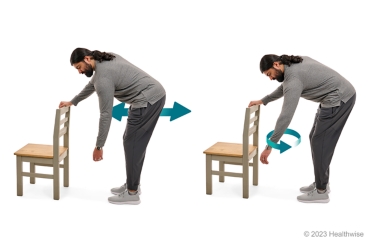
- Hold on to a table or the back of a chair with your unaffected arm. Then bend forward a little and let your affected arm hang straight down. This exercise does not use the arm muscles. Rather, use your legs and your hips to create movement that makes your arm swing freely.
- Use the movement from your hips and legs to guide the slightly swinging arm forward and backward like a pendulum (or elephant trunk). Then guide it in circles that start small (about the size of a dinner plate). Make the circles a bit larger each day, as your pain allows.
- Do this exercise for at least 1 minute. Do it at least 3 times a day.
As you have less pain, try bending over a little farther to do this exercise. This will increase the amount of movement at your shoulder.
Shoulder extensor stretch (supported)

- Standing about an arm's length away, grasp onto a solid surface. You could use a countertop, a doorknob, or the back of a sturdy chair.
- With your knees slightly bent, bend forward with your arms straight. Lower your upper body, and let your shoulders stretch. As your shoulders are able to stretch farther, you may need to take a step or two backward.
- Hold for at least 15 to 30 seconds. Then stand up and relax. If you stepped back during your stretch, step forward as you stand up so you can keep your hands on the solid surface.
- Repeat 2 to 4 times.
Shoulder stretch (posterior)

- Relax your shoulders. Hold the elbow of your affected arm with your other hand.
- Use your hand to pull your affected arm gently up and across your body. You will feel a gentle stretch across the back of your affected shoulder.
- Hold for at least 15 to 30 seconds, then slowly lower your arm.
- Repeat 2 to 4 times.
- If you can, repeat these steps for your other shoulder.
Up-the-back shoulder stretch
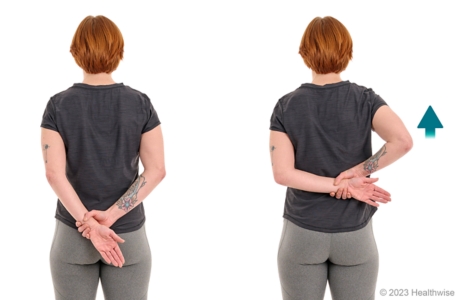
Your doctor or physical therapist may advise you to wait to do this stretch until you have regained most of your range of motion and strength.
- Stand or sit up straight. If you're standing, keep your feet about hip-width apart.
- Hold any of these stretches for at least 15 to 30 seconds.
- Repeat 2 to 4 times.
- If you can, repeat these steps for your other shoulder.
- Light stretch: Put the hand of your affected arm in your back pocket (palm outward). Let it rest there to stretch your shoulder.
- Moderate stretch: With your other hand, hold your affected arm (palm outward) behind your back by the wrist. Pull your arm up gently to stretch your shoulder.
- Advanced stretch: Put a towel over your other shoulder. Put the hand of your affected arm behind your back. Now hold the back end of the towel. With the other hand, hold the front end of the towel in front of your body. Pull gently on the front end of the towel. This will bring your hand farther up your back to stretch your shoulder.
Wall climb (to the side)
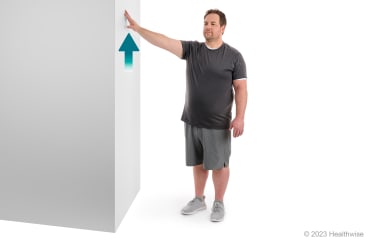
- Stand with your affected shoulder toward the wall, about an arm's length away.
- With your affected arm slightly in front of you (about 30 degrees), walk your fingers up the wall as high as pain permits. Keep your shoulder relaxed and down, not shrugged. Keep your body straight, and don't lean to the side.
- Hold that position for at least a few seconds.
- Slowly walk your fingers back down to the starting position.
- Repeat at least 2 to 4 times. Try to reach higher each time.
- It's a good idea to repeat these steps with your other arm.
Wall climb (to the front)
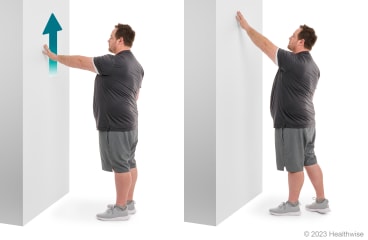
- Face a wall, and stand so your fingers can just touch it.
- Keeping your shoulder down (don't shrug), walk the fingers of your affected arm up the wall as high as pain permits. Keep your back straight. Don't arch your back.
- Hold that position for at least a few seconds.
- Slowly walk your fingers back down.
- Repeat at least 2 to 4 times. Try to reach higher each time. When you are able to reach higher, you can take a step toward the wall as you walk your fingers up, then step back as you walk your fingers back down.
- It's a good idea to repeat these steps with your other arm.
Strength-building exercises
Arm raises to the side and internal and external shoulder rotations are examples of strength-building exercises for rotator cuff problems.
You will also likely do exercises that help you keep or improve strength around the shoulder blade. They also can help your rotator cuff work as it should. These exercises are called scapular strengthening exercises. Examples are scapular arm reaches, wall push-ups, and resisted rows.
For any strengthening exercises where your arms start at or stretch from your sides, the motion should be on a diagonal. That means the motion should be about 30 degrees to the front of where your arms would be if you raised them straight out to the side.
Start these exercises only after your doctor says it's okay. Most often these exercises are started slowly, as soon as you can do the stretching without pain. But most people wait several weeks after surgery to do these exercises and others like them.
Arm raise to the side
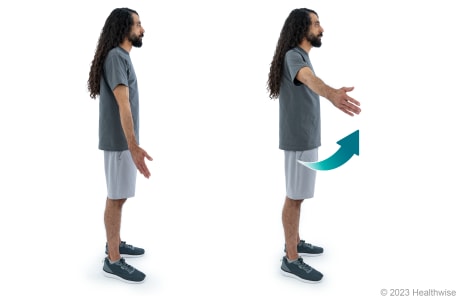
- Start with your affected arm at your side, with your palm facing forward.
- Slowly raise your affected arm to the side.
- Hold the position for 1 to 2 seconds. Then slowly lower your arm back to your side. If you need to, bring your other arm across your body and place it under the elbow as you lower your affected arm. Use that other arm to keep your affected arm from dropping down too fast.
- Repeat 8 to 12 times.
- It's a good idea to repeat these steps with your other arm.
- Keep your arm a little in front of your body (about 30 degrees), not straight out to the side.
- As you move, keep your shoulder relaxed (don't shrug) and your thumb up.
- Stop before your arm is at shoulder height.
When you first start out, don't hold any extra weight in your hand. As you get stronger, you may use a 1- to 2-pound weight, a small can of food, or a filled water bottle.
Shoulder external rotation (resisted)

- Tie the ends of an exercise band together to form a loop. Attach one end of the loop to a secure object, or shut a door on it to hold it in place. Or you can tie a knot in one end of the band and shut the door with the knot on the other side. The band should be at about waist height.
- Stand or sit with your unaffected side toward the door.
- Hold one end of the band with the hand of your affected arm, and bend your elbow to 90 degrees. Keep your upper arm against your body. You can squeeze a rolled towel between your elbow and your body for comfort. This will help keep your arm at your side.
- Start with your forearm across your belly and your shoulder relaxed. Slowly rotate your forearm out away from your body. Keep your elbow and upper arm tucked against the towel roll or the side of your body until you begin to feel tightness in your shoulder. Slowly move your arm back to where you started. Your shoulder should stay relaxed throughout the exercise.
- Repeat 8 to 12 times.
- It's a good idea to repeat these steps with your other arm.
Shoulder internal rotation (resisted)
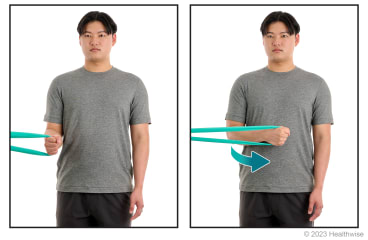
- Tie the ends of an exercise band together to form a loop. Attach one end of the loop to a secure object, or shut a door on it to hold it in place. Or you can tie a knot in one end of the band and shut the door with the knot on the other side. The band should be at about waist height.
- Stand or sit with your affected side toward the door.
- Hold the free end of the exercise band with the hand of your affected arm, and bend your elbow to 90 degrees. Keep your upper arm against your body. You can squeeze a rolled towel between your elbow and your body for comfort. This will help keep your arm at your side.
- Start with your arm pointing straight ahead and your shoulder relaxed. Slowly rotate your forearm toward your body until it touches your belly. As you do this, keep your elbow and upper arm firmly tucked against the towel or at your side. Slowly move it back to where you started. Your shoulder should stay relaxed throughout the exercise.
- Repeat 8 to 12 times.
- It's a good idea to repeat these steps with your other arm.
Shoulder flexion (isometric)
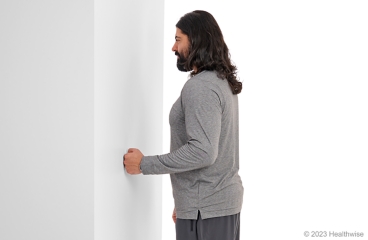
- Hold your affected arm against your body, and bend your elbow about 90 degrees (like the letter "L"), with your hand straight ahead. Make a closed fist, with your thumb on top.
- Face a wall, and step forward until your fist is against the wall. Your elbow should still be against your body.
- Press your fist against the wall with about half of your strength or less. Don't let your body move backward as you press.
- Hold for about 6 seconds, and then relax.
- Repeat 8 to 12 times.
- It's a good idea to repeat these steps with your other arm.
Shoulder extension (isometric)
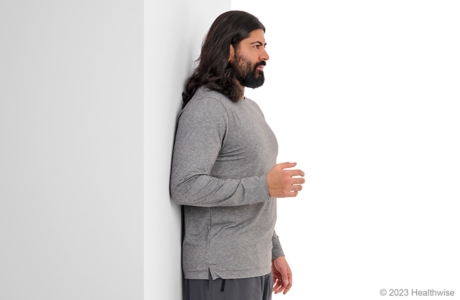
- Stand with your back against a wall and the upper part of your affected arm against the wall. Bend your elbow about 90 degrees (like the letter "L"), with your hand straight ahead.
- Press your elbow back against the wall with about half of your strength or less. Don't let your body move forward as you press.
- Hold for about 6 seconds, and then relax.
- Repeat 8 to 12 times.
- It's a good idea to repeat these steps with your other arm.
Scapular arm reach (lying down)
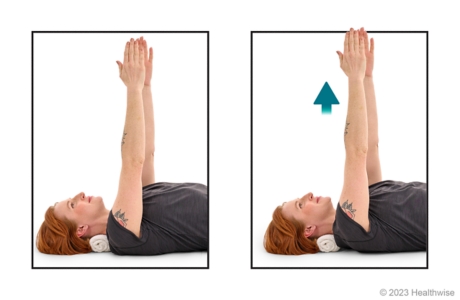
- Lie on your back on a firm surface, like the floor or a firm bed. You can bend your knees or put a pillow under your knees.
- Point your arms toward the ceiling. Keep your elbows straight.
- Reach higher toward the ceiling. Keep your elbows straight. All motion should be from your shoulder blades. Your shoulders will come off the floor or bed a little bit.
- Slowly relax and return your arms to the starting position.
- Repeat 8 to 12 times.
Wall push-up

- Stand facing a wall with your feet about 12 to 24 inches from the wall. If you feel any pain when you do this exercise, stand closer to the wall.
- Place your hands on the wall at shoulder height, slightly wider apart than your shoulders. Turn your fingers out a little, rather than straight up and down.
- Slowly bend your elbows and bring your face toward the wall, keeping your shoulders and hips lined up. Then slowly push back to the starting position. Keep the motion smooth and controlled.
- Repeat 8 to 12 times.
When you can do this exercise against a wall with ease and no pain, you can try it against a counter. You can then slowly progress to the end of a couch, then to a sturdy chair, and finally to the floor.
Resisted row
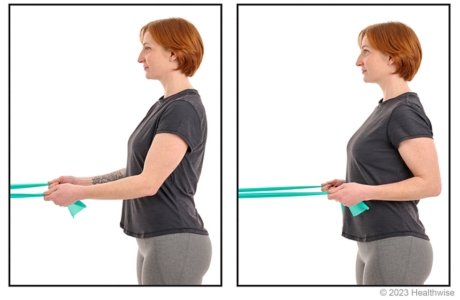
- Anchor an exercise band at about waist level. You can loop the band around a solid object, like a bedpost or handrail. Or you can tie a knot in the middle of the band and shut a door on the band so the knot is on the other side of the door. (Or you can have someone hold one end of the loop to provide resistance.)
- Stand or sit facing where you have placed the band. Hold one end of the band in each hand.
- Hold your arms out in front of you. Adjust your hold on the band so you have some tension on it.
- With your shoulders relaxed, pull the bands back, and move your shoulder blades toward each other. Your elbows will pass along your waist.
- Slowly return to the starting position.
- Repeat 8 to 12 times.
Credits
Current as of: July 31, 2024
Author: Ignite Healthwise, LLC Staff
Clinical Review Board
All Healthwise education is reviewed by a team that includes physicians, nurses, advanced practitioners, registered dieticians, and other healthcare professionals.
Current as of: July 31, 2024
Author: Ignite Healthwise, LLC Staff
Clinical Review Board
All Healthwise education is reviewed by a team that includes physicians, nurses, advanced practitioners, registered dieticians, and other healthcare professionals.
This information does not replace the advice of a doctor. Ignite Healthwise, LLC disclaims any warranty or liability for your use of this information. Your use of this information means that you agree to the Terms of Use and Privacy Policy. Learn how we develop our content.
To learn more about Ignite Healthwise, LLC, visit webmdignite.com.
© 2024 Ignite Healthwise, LLC. Healthwise, Healthwise for every health decision, and the Healthwise logo are trademarks of Ignite Healthwise, LLC.



